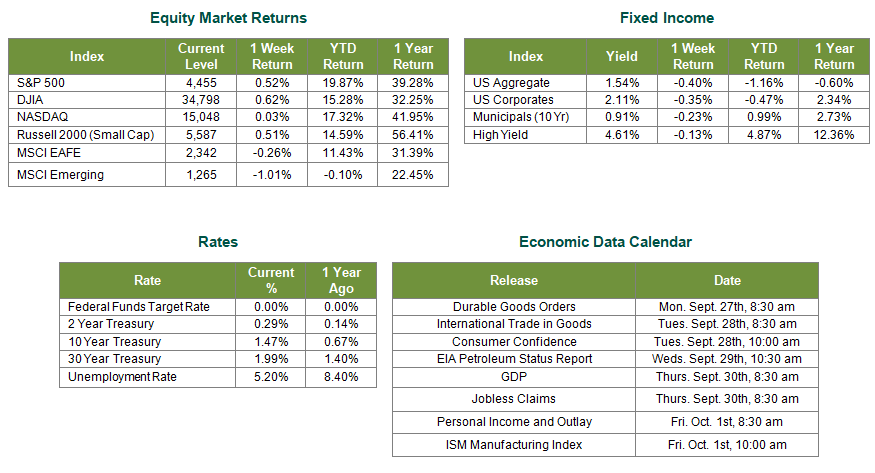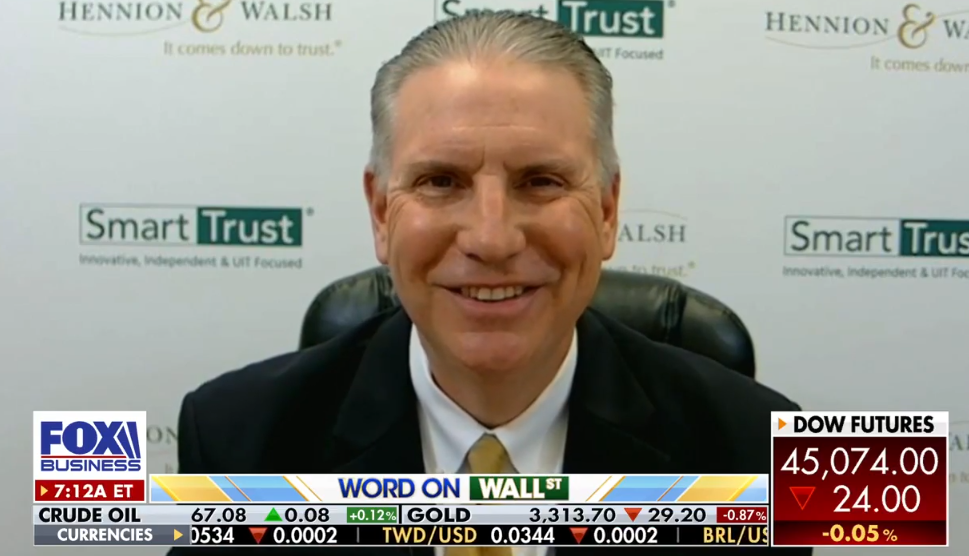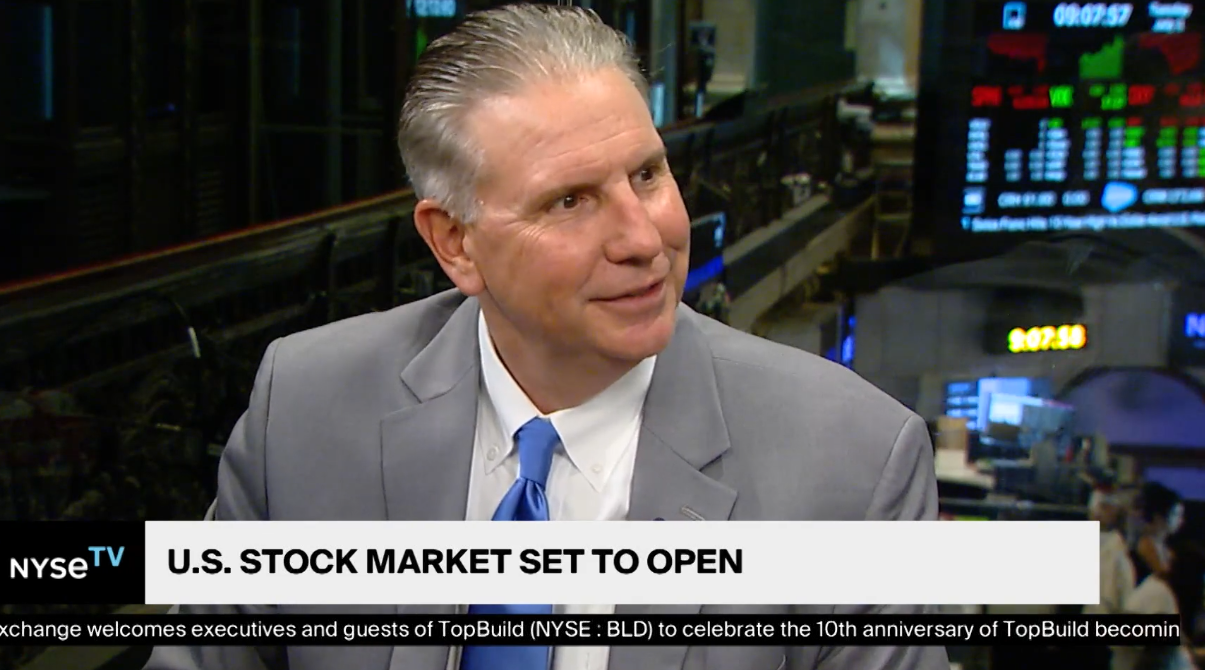
Last Week’s Markets in Review: Making Sense of Evergrande, China, and the Federal Reserve

U.S. markets were able to rebound from a sharp sell-off to finish in positive territory for the week. The S&P 500 Index closed the week at a level of 4,455, representing a gain of 0.52%, while the Russell Midcap Index moved 0.70% higher. Meanwhile, the Russell 2000 Index, a measure of the Nation’s smallest publicly traded firms, returned 0.51% over the week. International equity performance wasn’t as encouraging as developed and emerging markets returned -0.26% and -1.01%, respectively. Finally, the 10-year U.S. Treasury yield moved 10 basis points higher over the week, closing at 1.47% on Friday.
Leading up to last week, investors were eagerly awaiting the arrival of the highly anticipated September Federal Open Market Committee (FOMC) meeting. But before the Fed could even speak, news out of China on Monday would send markets to their most significant single-day drop since May. We’ve received many inquiries from clients on the China story surrounding real estate giant Evergrande and its potential economic impact/implications. Evergrande is a Chinese real estate developer with many subsidiaries that runs more than 1,300 projects in over 280 cities. More importantly, on the liability side of the balance sheet, the company has the equivalent of approximately $300 billion in debt linked to various banks. To help gauge the size of this heavily indebted real estate developer, consider that Evergrande’s assets are equivalent to about 2% of China’s gross domestic product, according to Goldman Sachs. In short, the company has had issues servicing debt in the past and recently came out stating that default is once again possible. A default would impact their direct lenders and the broader real estate market, and the Chinese consumer. This impact could potentially drive down Chinese demand for international products, commodities, and services. Investors were rattled by the potential ripple effect or a more frightening risk term…contagion. Evergrande is working on debt restructuring, but it’s still unclear whether looming obligations or government intervention will help curb a potential global shock.
Combined with other lingering market concerns on investors’ minds, the S&P 500 fell 1.7% on Monday while the Nasdaq Composite gave back 2.2% on the Evergrande news. Many strategists have called for a potential market pullback (decline of 5% – 10%) or even a market correction (10% – 20%) in the not too distant future. However, Evergrande would not be the catalyst as the S&P 500 regained all lost ground leading to and through the Federal Reserve’s announcement following their meeting on Wednesday.
The announcement mentioned above was relatively benign. The target rate and asset purchases remain unchanged. Federal Reserve Chairman Jay Powell noted that tapering “may soon be warranted,” and we believe that the Federal Reserve (Fed) will likely announce their tapering plans after their next scheduled FOMC meeting in November.
In other areas, the Fed:
• Revised their GDP forecast for 2021 down to 5.9%, compared with a 7.0% forecast in June.
• Sees inflation increasing to 3.7% in 2021 but then declining to 2.3% in 2022.
• Moved their forecast for unemployment in 2021 marginally higher to a range of 4.6% – 4.8% versus 4.4% – 4.8% in June.
• Forecasts unemployment in a range of 3.6% to 4.0% in 2022 and a range of 3.3% to 3.7% in 2023.
Adding Evengrande’s issues to the laundry list of other current market and economic concerns may result in confusion and anxiety for some investors. As a result, we encourage investors to work with experienced financial professionals to help build and manage asset allocations within their portfolios consistent with their objectives, timeframe, and tolerance for risk.
Best wishes for the week ahead!
Sources for data in tables: Equity Market and Fixed Income returns are from JP Morgan as of 9/24/21. Rates and Economic Calendar Data from Bloomberg as of 9/24/21. International developed markets measured by the MSCI EAFE Index, emerging markets measured by the MSCI EM Index, U.S. Large Cap defined by the S&P 500. Sector performance is measured using the GICS methodology.
Disclosures: Past performance does not guarantee future results. We have taken this information from sources that we believe to be reliable and accurate. Hennion and Walsh cannot guarantee the accuracy of said information and cannot be held liable. You cannot invest directly in an index. Diversification can help mitigate the risk and volatility in your portfolio but does not ensure a profit or guarantee against a loss.
Diversification can help mitigate the risk and volatility in your portfolio but does not ensure a profit or guarantee against loss.
Investing in commodities is not suitable for all investors. Exposure to the commodities markets may subject an investment to greater share price volatility than an investment in traditional equity or debt securities. Investments in commodities may be affected by changes in overall market movements, commodity index volatility, changes in interest rates or factors affecting a particular industry or commodity.
Products that invest in commodities may employ more complex strategies which may expose investors to additional risks.
Investing in fixed income securities involves certain risks such as market risk if sold prior to maturity and credit risk especially if investing in high yield bonds, which have lower ratings and are subject to greater volatility. All fixed income investments may be worth less than the original cost upon redemption or maturity. Bond Prices fluctuate inversely to changes in interest rates. Therefore, a general rise in interest rates can result in the decline of the value of your investment.
Definitions
MSCI- EAFE: The Morgan Stanley Capital International Europe, Australasia and Far East Index, a free float-adjusted market capitalization index that is designed to measure developed-market equity performance, excluding the United States and Canada.
MSCI-Emerging Markets: The Morgan Stanley Capital International Emerging Market Index, is a free float-adjusted market capitalization index that is designed to measure the performance of global emerging markets of about 25 emerging economies.
Russell 3000: The Russell 3000 measures the performance of the 3000 largest US companies based on total market capitalization and represents about 98% of the investible US Equity market.
ML BOFA US Corp Mstr [Merill Lynch US Corporate Master]: The Merrill Lynch Corporate Master Market Index is a statistical composite tracking the performance of the entire US corporate bond market over time.
ML Muni Master [Merill Lynch US Corporate Master]: The Merrill Lynch Municipal Bond Master Index is a broad measure of the municipal fixed income market.
Investors cannot directly purchase any index.
LIBOR, London Interbank Offered Rate, is the rate of interest at which banks offer to lend money to one another in the wholesale money markets in London.
The Dow Jones Industrial Average is an unweighted index of 30 “blue-chip” industrial U.S. stocks.
The S&P Midcap 400 Index is a capitalization-weighted index measuring the performance of the mid-range sector of the U.S. stock market, and represents approximately 7% of the total market value of U.S. equities. Companies in the Index fall between S&P 500 Index and the S&P SmallCap 600 Index in size: between $1-4 billion.
DJ Equity REIT Index represents all publicly traded real estate investment trusts in the Dow Jones U.S. stock universe classified as Equity REITs according to the S&P Dow Jones Indices REIT Industry Classification Hierarchy. These companies are REITs that primarily own and operate income-producing real estate.



